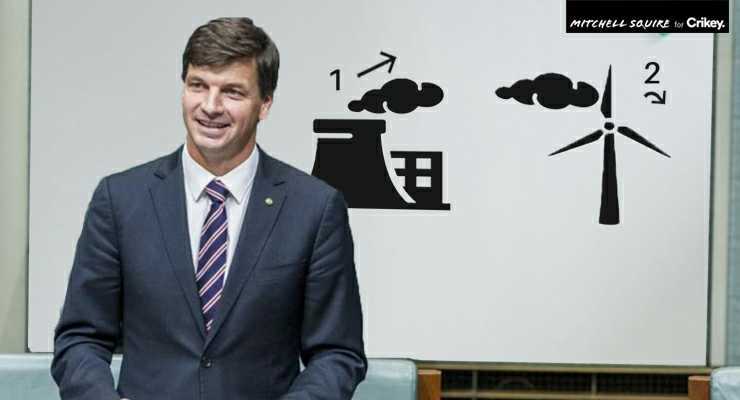
“Technology not taxes,” the Morrison government screams. Its plan to reduce emissions, even before making any commitment to net zero by 2050, is to invest in a suite of newer, more renewable technologies. The problem is that not all of them work that well, and not all of them are that much more renewable. Here’s five of the key technologies the government is relying on.
Hydrogen
In the budget, the government promised $275.5 million towards developing a series of hydrogen “hubs” in regional Australia. Because hydrogen is cheap, plentiful, and produces no emissions, it’s long been considered a future fuel source. But because it combusts easily and is tough to transport, there are doubts around its suitability for, say, powering cars. Where hydrogen could be most effective is in powering emissions-heavy manufacturing industries (more on that later).
But there’s a catch: not all hydrogen is emissions neutral. It requires a huge amount of energy to extract in a pure, usable form. One way of doing that is with gas or coal-fired power. This is highly emissions intensive. The gold standard is “green hydrogen,” where solar or wind power — which Australia has plenty of — is used to electrolyse water and separate hydrogen. Australia has the potential to become a green hydrogen “superpower” according to the Lowy Institute, which could account for a quarter of global energy demand by 2050.
Then there’s “blue” or “clean” hydrogen, which uses coal or natural gas to extract hydrogen, but then catches the CO2 emissions and stores them underground. Which brings us to…
Carbon capture and storage
We hear about this a lot, especially from the Nationals. It’s basically a neat trick that allows the coal industry to keep chugging along, except emissions are caught and stored underground. The Morrison government earmarked $250 million in the budget to support its development along with hydrogen, and will give little treats (carbon credits) to fossil fuel companies that use it. That’s a clear sign of what kind of hydrogen the government supports.
But here’s the thing: CCS doesn’t have a good track record. Even mining billionaire Andrew “Twiggy” Forrest, now an evangelist for green hydrogen, reckons it “fails 19 out of 20 times.” Former prime minister Malcolm Turnbull calls it a “scam”. The Climate Council says it’s a “big expensive failure”.
Australia is home to the biggest, most expensive of those failures in the world — Chevron’s Gorgon Gas Plant off the coast of Western Australia. The plant aimed to capture and inject 80% of CO2 produced. So far, it’s gotten about 30%.
That didn’t stop Nationals Deputy Leader David Littleproud talking up CCS last Friday as being key to extending the life of coal-fired power stations while keeping emissions down. It will definitely do one of those things.
Green steel
As we mentioned, hydrogen’s greatest potential is in emissions-heavy manufacturing. One of those sectors is production of steel, where iron ore, which Australia produces in abundance, is blasted in a coal-fired furnace to strip away excess oxygen. Steel production accounts for 7% of worldwide emissions.
“Green” steel is made using energy from renewable-extracted green hydrogen, instead of coal. It’s got a range of backers as a potentially lucrative export industry for Australia. While we produce a lot of iron ore, we don’t make very much steel. With the right policy settings, that could change.
Forrest is a big believer in green steel and is planning to build a plant in the Pilbara. Progressives have also voiced their support for green steel. Analysis from the Grattan Institute found it could become an export market with $65 billion annually, creating 25,000 jobs in NSW and Queensland. Greens Leader Adam Bandt says green steel will be key to getting a just transition for workers in the coal sector.
Long-duration energy storage (i.e. batteries)
“Find me a solar panel that works in the dark,” Resources Minister Keith Pitt told question time last Thursday. That’s where batteries come into play, as a technology to support the electricity grid when the sun doesn’t shine and the wind doesn’t blow without resorting to coal-fired power.
There’s already movement here from the big polluters. Last year, AGL announced the development of a long-duration battery in South Australia. This year, the British government created a competition where developers could win funding to create a battery.
And while the Morrison government is now offering millions to researchers who want to help Australia develop battery storage, let’s not forget the prime minister’s own past statements on this. When the South Australian government announced a collaboration with Elon Musk to build the world’s largest lithium ion battery, Morrison pulled out the gags.
“I mean, honestly, by all means have the world’s biggest battery, have the world’s biggest banana, have the world’s biggest prawn like we have on the roadside around the country, but that is not solving the problem,” the then treasurer said.
Soil carbon
Essentially, this is about improving agricultural practices to take CO2 from the air and store it in the ground. It’s also a favourite of the Nationals, who’ve pushed for more support for farmers to do it. Despite government interest, its effectiveness at reducing agricultural emissions on its own is still unclear.
And according to a report from the Grattan Institute, as an emissions reduction tool, soil carbon is vulnerable to changes in the climate. Hotter and drier temperatures reduce plant growth, making it harder to return organic matter to the soil.








Of these technologies, CCS is the worst. Over decades of “development” it’s proven to be great at absorbing taxpayer funds (government grants), but not so good at absorbing CO2.
The problem with CCS in a nutshell:
“The plant aimed to capture and inject 80% of CO2 produced.”
Even working to its maximum potential, 20%, of the CO2 produced still escapes.
Reminds me of that old joke about a forger, a shonky accountant and a con-man walking into a bar and ask the barman “Do you cash cheques?”…..
“If these “technological developments”, that we’re relying on, don’t eventuate, or come up short – that’s hardly my government’s fault. We could hardly be expected to have a Plan B. We’re only the government after all.”?
And “mandates”/”compulsion”? No, everybody can ‘let their conscience be their guide’ – from a government with no conscience at all?
That’s a joke?
Sounds more like a description of the Ministry – Angas, Barnyard & Scummo respectively.
Really?
With the publican being the Public.
Geo-Sequestration (Carbon Capture and Storage) is nothing more than a money-pit and a scam. Decades of R&D, and many billions of dollars of investment, and there still isn’t even a break-even facility in operation….let alone one that can operate at a profit. You’d be better off investing in Nuclear Fusion.
While CCS is given any breath, it provides an excuse for continuing to emit by cheating on the quantities. Spin doctors of Scomo’s school can poker-faced assert that the next emitting power station can go ahead because we’re gonna put the stuff underground. Trusting souls will fail to see that only a negligible fraction can be put underground (destroying a hidden environment) temporarily, while most of the emissions will go permanently into the greenhouse.
He’s just a liar who will say and do anything to get elected. Throwing his words back in his face proves that fact — we need more of that. Albanese worries me – he doesn’t seem to be able to lay a glove on this charlatan.